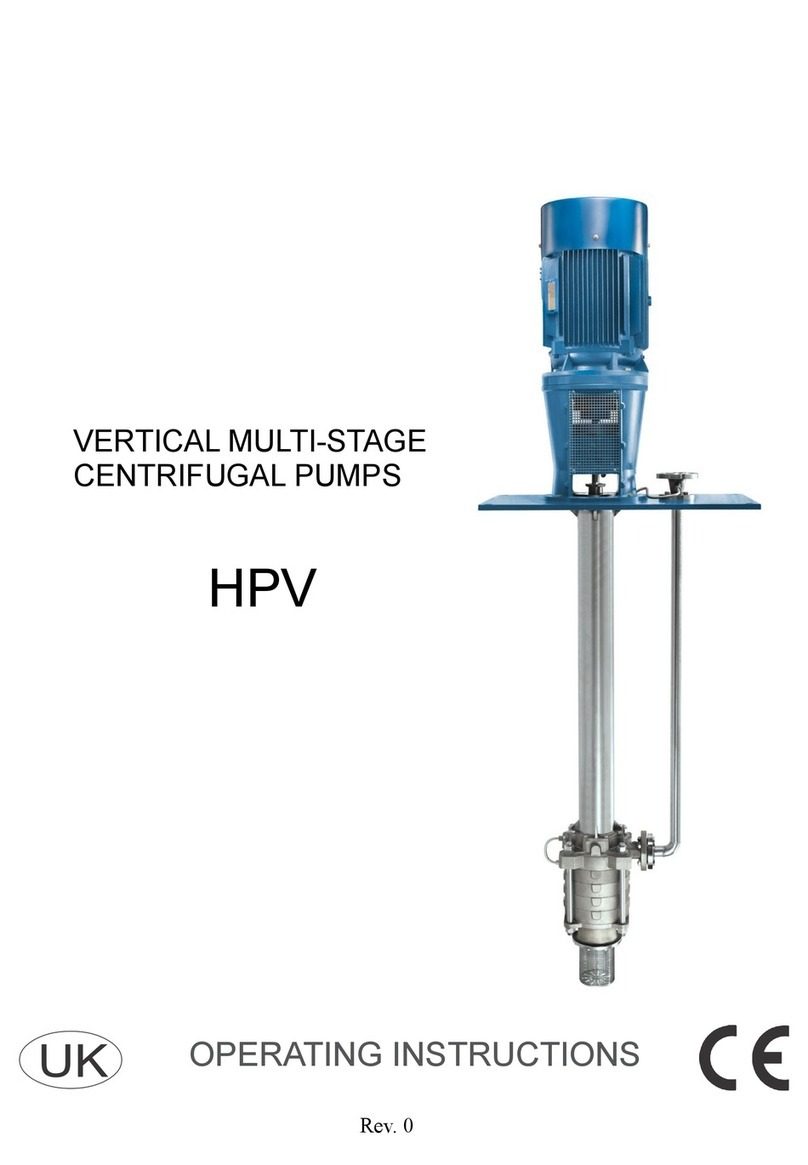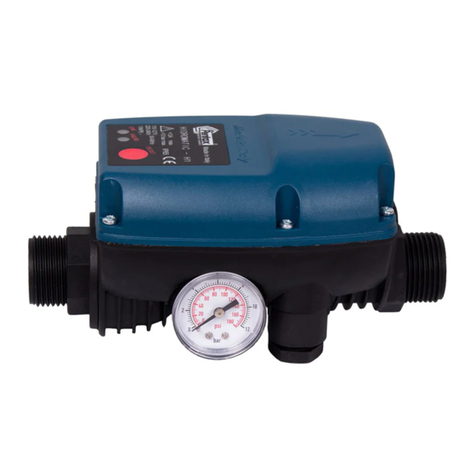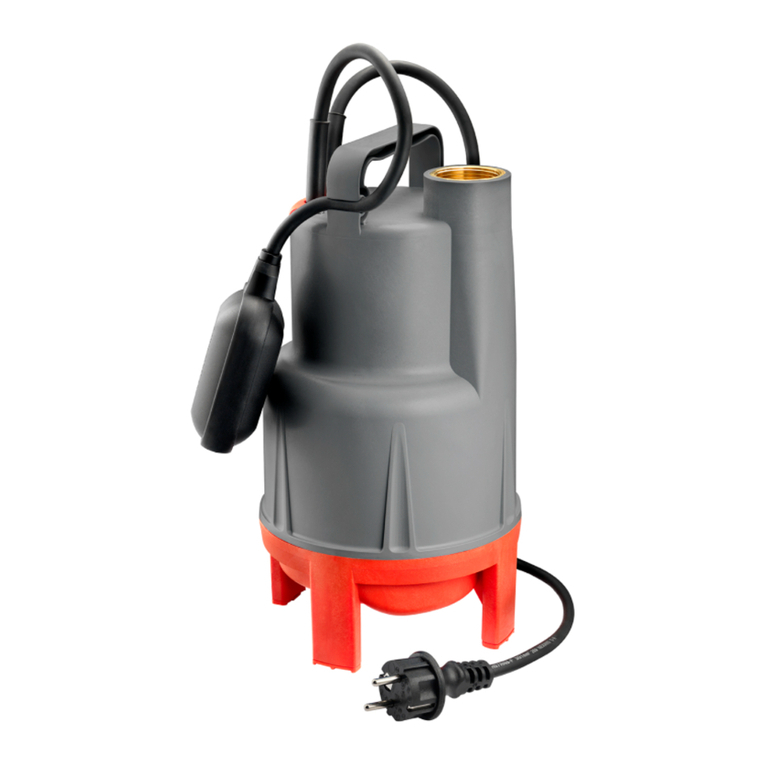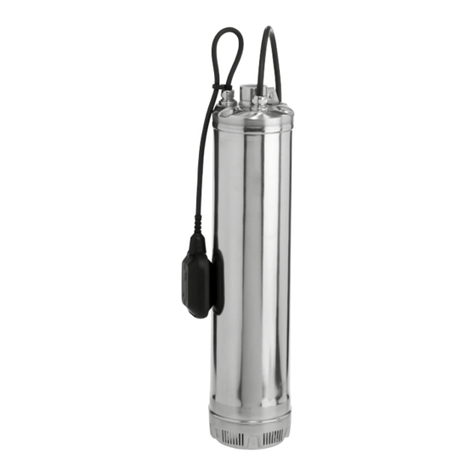• Pour les puits avec un diamètre fort supérieur à celui du groupe, installer une chermise externe au
moteur afin de garantir une vitesse d’eau de refroidissement ≥0,1 m/s.
• Câler l’électropompe avant d’atteindre le fond du puits (X) pour éviter un mauvais refroidissement du
moteur à cause de sédiments; le niveau dynamique (A) du puits ne doit influencer en aucun cas le fonc-
tionnement. Munir l’installation de protections électriques et de contrôles automatiques de niveau (3).
• En surface installer toujours au moins un clapet anti-retour (6) pour protéger la pompe contre les
coups de bélier issus du circuit a mont.
L’installation du groupe en position horizontale est à spécifier à l’achat, à tenir compte: que l’axe de la
pompe soit installé à 0,5 m au dessus du fond, que l’air de l’installation s’evacue facilement, qu’un cla-
pet de retenue supplémentaire soit prévu.
CONNEXIONS ÉLECTRIQUES
Après installation, recontrôler le câble d’alimentation conformément au paragraphe JONCTION DES
CÂBLES et le brancher au coffret de commande (1) qui sera muni suivant les normes en vigueur:
• D’un dispositif omnipolaire pour désinsertion-séparation de la ligne (minimum d’ouverture des
contacts 3 mm).
• De protections contre court-circuits (fusibles Am) et magnétotermiques, calibrées en fonction de l’in-
tensité nominale.
• D’éventuels dispositifs contre: défauts de phases, dispersions de courant, manque d’eau, d’écharges
atmosphériques et des signalisations de fonctionnement ou de panne.
IMPORTANT
TOUTES LES MASSES ÉLECTRIQUES SERONT RACCORDÉES AU CIRCUIT DE TERRE DE L’INSTALLA-
TIONS. TOUS LES BRANCHEMENTS SERONT EXÉCUTÉS CONFORMÉMENT AUX NORMES PAR DU
PERSONNEL HABILITÉ.
PREMIÈRE MISE EN ROUTE
• Avec vanne de refoulement (5) totalement ouverte, attendre que tout l’air soit expulsé des canalisa-
tions; fermer persqu’entièrement la vanne et mettre en route l’électropompe et attendre qu’il sorte des
canalisations, de l’eau sans bulles d’air.
Fermer la vanne et contrôler sur le manomètre (4) que la pression maximale corresponde à celle du
catalogue, en cas contraire, inverser le sens de rotation uniquement pour moteurs triphasés.
• Ouvrir par paliers la vanne en faisant fonctionner la pompe jusqu’à obtenir l’arrivée d’eau limpide. Un
puits construits correctement et préalablement purgé donnera des eaux claires en moins de 15 minutes.
• Durant les séquences précédentes, contrôler la tension et le courant en tollérant des écarts intermit-
tens de ±5% sur les valeurs indiquées sur plaque signalétique.
FONCTIONNEMENT NORMAL
Raccorder le groupe au circuit de distribution, contrôler pendant quelques cycles de travail les para-
mètres de tension et courant, éventuellement retoucher les réglages de débit, pression et des protec-
tions électriques.
ATTENTION
• NE JAMAIS FAIRE FONCTIONNER LA POMPE À SEC.
• NE JAMAIS DÉPASSER PLUS DE 2 MINUTES DE FONCTIONNEMENT AVEC VANNE DE DÉBIT TOTA-
LEMENT FERMÉE.
• NE JAMAIS FAIRE TOURNER LA POMPE EN SENS INVERSE PLUS DE 30 SECONDES.
ENTRETIEN
Contrôler souvent l’installation en éliminant les causes perturbantes (sable, calcaire etc.), entretenir tou-
jours en bon état les organes sujets à disfonctions (valves, filtres, détecteurs et protections). Intervenir
avec un maximum de soins en faisant appel à du personnel habileté et qualifié. En cas de longues
périodes d’inactivité prévoir à démarrer souvent l’installation.
ATTENTION:
AVANT CHAQUE INTERVENTION D’ENTRETIEN, S’ASSURER QU’IL N’Y A PLUS DE PRESSION DANS
L’INSTALLATION. DÉBRANCHER L’ALIMENTATION ÉLECTRIQUE.


































